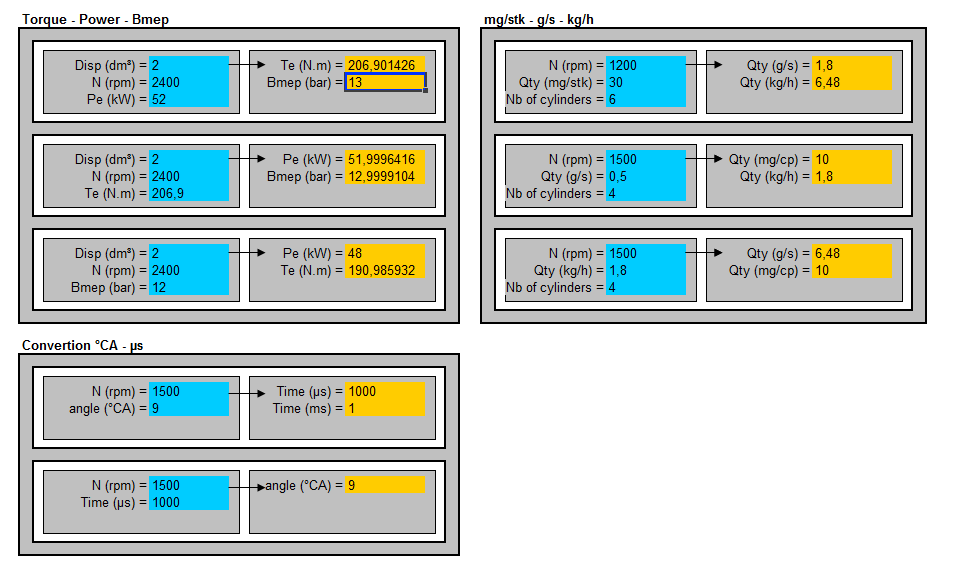Mitsubishi Motors Corporation (MMC) announced today that the new Outlander PHEV will go on sale at dealerships throughout Japan from January 24, 2013. Powered by the Plug-in Hybrid EV System powertrain derived from MMC’s lineup of electric vehicles (EVs), the Outlander PHEV will have a manufacturer’s suggested retail price (MSRP) of ¥3,324,000 (29,000 €, $38,600) – ¥4,297,000 (37,800€, $49,900) (including consumption tax).
The world’s first plug-in hybrid SUV, the Outlander PHEV represents a fusion of the EV technologies developed by MMC for models such as the i-MiEV, 4WD technologies honed in the Lancer Evolution, and SUV know-how gained from the Pajero (Montero or Shogun in some countries). The result is a groundbreaking new model that brings together the superior environmental performance and quietness of an EV, the stability and handling of a 4WD, and the practicality of a SUV, so that the driver can enjoy the benefits of:
- Environmentally-friendly all-electric operation for everyday use and mainly motor-powered hybrid operation for longer journey
- Outstanding motive performance from its Twin Motor 4WD System
- Unique functionality made possible by the high-capacity battery, including 100V AC power supply capable of delivering up to 1,500 W of electricity as an external power source and Battery Charge Mode which allows the battery to be charged by the engine either when stationary or on the move
Main Features of the Outlander PHEV
The unique combination of electric motors and gasoline engine gives flexibility in optimizing fuel efficiency and environmental performance while providing a long cruising range. For example, on electric power only, the vehicle has a cruising range of 60.2 km (measured via Japan’s JC08 mode), enabling it to function entirely as an EV in most everyday situations. It also has a total cruising range on a par with internal combustion engine (ICE) vehicles (897 km at JC08 mode), making it perfectly suited for uses traditionally associated with SUVs, such as long-distance travel and outdoor and leisure activities.
The optimum drive mode for comfortable and fuel-efficient driving is automatically selected depending on driving conditions and remaining battery charge. Gasoline consumption is minimized by actively utilizing electric power, keeping the gasoline engine in its most efficient range, and by recovering energy during deceleration via regenerative braking. This results in a plug-in hybrid fuel efficiency (combined fuel efficiency) of 67.0 km/l (1.5 l/100km) and hybrid fuel efficiency of 18.6 km/l (5.4 l/100km), both on JC08 mode.
The three drive modes
EV Drive Mode: 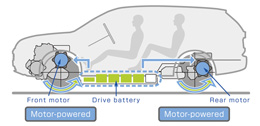 EV Drive Mode is an all-electric mode in which the front and rear motors drive the vehicle using only electricity from the drive battery. With zero on-road gasoline consumption and zero CO2 emissions the driver can enjoy quiet and eco-friendly performance in this mode. EV Drive Mode is an all-electric mode in which the front and rear motors drive the vehicle using only electricity from the drive battery. With zero on-road gasoline consumption and zero CO2 emissions the driver can enjoy quiet and eco-friendly performance in this mode. |
Series Hybrid Mode: 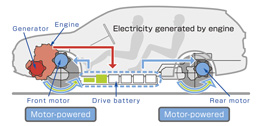 In Series Hybrid Mode the gasoline engine operates as a generator supplying electricity to the electric motors. The system switches to this mode when the remaining charge in the battery falls below a predetermined level and when more powerful performance is required, such as accelerating to pass a vehicle or climbing a steep gradient such as a slope. In Series Hybrid Mode the gasoline engine operates as a generator supplying electricity to the electric motors. The system switches to this mode when the remaining charge in the battery falls below a predetermined level and when more powerful performance is required, such as accelerating to pass a vehicle or climbing a steep gradient such as a slope. |
Parallel Hybrid Mode: 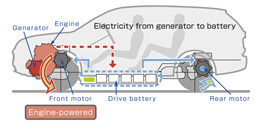 The system switches to Parallel Hybrid Mode when the vehicle reaches high speeds. In this mode the high-efficiency gasoline engine provides most of the motive power, assisted by the electric motors as required, such as when more powerful performance is required to accelerate or climb a slope. The system switches to Parallel Hybrid Mode when the vehicle reaches high speeds. In this mode the high-efficiency gasoline engine provides most of the motive power, assisted by the electric motors as required, such as when more powerful performance is required to accelerate or climb a slope. |
Twin Motor 4WD System Provides Superior Response
The pairing of the all-new Twin Motor 4WD with MMC’s S-AWC (Super All Wheel Control) integrated vehicle dynamics control system delivers greater stability, ensuring the vehicle behaves just as the driver intends and assisting safe, comfortable driving under a range of road conditions. As an inherent characteristic of electric motors, they generate high torque instantly; giving acceleration comparable to that of a vehicle powered by a large displacement high-output ICE and allowing Outlander PHEV to deliver superior levels of environmental and driving performance.
High-capacity Drive Battery Offers Driving Versatility
The 100V AC power supply can produce up to 1,500W of 100 V alternating current from dual interior outlets to power all kinds of appliances for outdoor leisure use and in emergencies. These can provide roughly one day’s worth of power for ordinary home appliances and up to around 10 days’ worth when power generation by the engine is factored in.
The battery can be switched to Battery Charge Mode, which allows electricity to be generated by the engine and stored when stationary or on the move (giving 80% charge in approximately 40 minutes when stationary) and Battery Save Mode, which maintains charge while driving. Stored electricity can be used in EV Drive Mode at the destination or used to power appliances.
Plug-in Hybrid EV System
The Plug-in Hybrid EV System was developed based on the EV technologies used in the i-MiEV and MINICAB-MiEV for use in mid-size and larger passenger cars that require longer cruising ranges. Key components such as the battery and motor are constantly monitored, and integrated control is maintained over the engine, Twin Motor 4WD, regenerative brakes, air conditioning, and so on to ensure safe, comfortable, and fuel efficient driving.
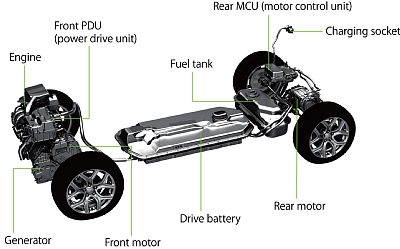
Drive Battery
The drive battery is a high-capacity lithium-ion battery developed for the PHEV System based on the technology used in the i-MiEV and MINICAB-MiEV (16.0 kWh models). It consists of 80 cells mounted in series housed in a battery pack enclosed in a secure frame, and has a total voltage of 300V and total storage capacity of 12.0 kWh.
Electric Motors
Smaller, lighter, higher output versions of the permanent magnet synchronous motors used in the i-MiEV and MINICAB-MiEV are located front and rear. These have a maximum output of 60 kW each and maximum torques of 137 Nm (front) and 195 Nm (rear).
Internal Combustion Engine
The 4B11 2.0-liter inline-four gasoline engine functions solely to generate electricity in Series Hybrid Mode and is mainly used to provide motive power in Parallel Hybrid Mode. It is fitted with MMC’s MIVEC technology, which keeps the engine in optimal efficiency ranges by continuously varying the timing of the air intake valves according to engine speed in Parallel Hybrid Mode. Additionally, exhaust noise has been reduced and the engine room soundproofing increased in order to ensure the vehicle remains as quiet as EV Drive Mode, even when the engine is in use.
Generator
In Series/Parallel Hybrid Mode and in Battery Charge/Save Mode, the generator generates electricity through motive power from the engine to store into the drive battery.
Transaxles
Taking advantage of the fact that electric motors require no complex transmission mechanisms, the front and rear transaxles incorporate simple single-speed fixed reduction gears for smoother travel free from “shift shock”. The front transaxle also has a built-in clutch that switches the system to Parallel Drive Mode mainly for engine-powered travel at high speeds.
Twin Motor 4WD system
Leveraging its proven expertise in 4WD control technology, MMC has developed a new Twin Motor 4WD system that delivers power independently to the front wheels (from the front motor and/or engine) and rear wheels (from the rear motor). The use of motors and absence of mechanical connections such as a propeller shaft mean the Twin Motor 4WD delivers better response and finer control than conventional 4WD systems and reduces friction loss through the removal of coupling device.Twin Motor 4WD is coupled with MMC’s S-AWC (Super All Wheel Control) integrated vehicle dynamics control system, which combines front- and rear-wheel drive control and left and right wheel brake control to provide consistent handling and stability on the road. Two modes are offered, selectable with a switch: Normal Mode for ordinary conditions and Lock Mode for enhanced all-terrain performance.
Regenerative braking
During deceleration, the motors function as generators so that electricity can be generated to charge the drive battery. The strength of regenerative braking is adjustable using the selector lever, which has three strength settings, and a paddle selector on the steering wheel, which offers six strength settings. The regeneration level can be selected as the driver likes according to road conditions, such as when approaching a bend or descending a mountain road, or when seeking a sportier ride, allowing the driver to get just the right amount of desired brake force from the system.
Technical specifications of the Outlander PHEV
| Overall length x width x height (mm) | 4655 x 1800 x 1680 | |
| Wheelbase (mm) | 2670 | |
| Tires | 225/55 R18 | |
| Vehicle weight (kg) | 1770 – 1820 | |
| Motors | Type | Permanent magnet synchronous |
| Max output (net) | Front: 60 kW (82 hp)Rear: 60 kW (82 hp) | |
| Max torque (net) | Front: 137 NmRear: 195 Nm | |
| Battery | Type | Lithium-ion |
| Total voltage | 300 V | |
| Rated capacity | 12 kWh | |
| Engine | Type | 2.0-liter 4-cyl. DOHC MIVEC gasoline engine |
| Max output (net) | 87 kW (118 hp) @ 4500 rpm | |
| Max torque (net) | 186 Nm @ 4500 rpm | |
| Estimated charging times | 200 V AC (15 A) | Approx. 4 hours (full charge) |
| Quick-charging time | Approx. 30 minutes (80% charge) | |
| Plug-in cruising range | 60.2 km with the Japanese JC08 test cycle | |
| Combined fuel efficiency | 67.0 km/l (1.5 l/100km) with the Japanese JC08 test cycle | |
| Hybrid fuel efficiency | 18.6 km/l (5.4 l/100km) with the Japanese JC08 test cycle | |
Romain Nicolas opinion:
Plug-in hybrid electric vehicle is, according to me, the next intermediate step before the real take-off of pure electric vehicles. Do you think there will be adaptation of the infrastructure to be able to reload this kind of vehicle, at work or at home? Don’t you think we should first develop infrastructure before developing PHEV or pure electric vehicles?






